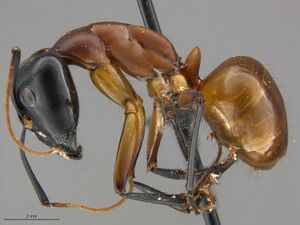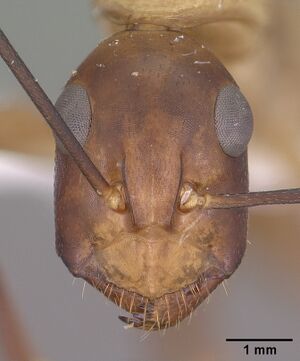Camponotus ocreatus
| Camponotus ocreatus | |
|---|---|

| |
| Scientific classification | |
| Kingdom: | Animalia |
| Phylum: | Arthropoda |
| Class: | Insecta |
| Order: | Hymenoptera |
| Family: | Formicidae |
| Subfamily: | Formicinae |
| Tribe: | Camponotini |
| Genus: | Camponotus |
| Species: | C. ocreatus |
| Binomial name | |
| Camponotus ocreatus Emery, 1893 | |
| Synonyms | |
| |
This species nests under stones in rocky loam soils, often on north-facing slopes and often in partial shade at the edges of forests.
Identification
Majors, minors and females can be recognized by having no erect hairs on the cheeks or sides of the head, the bases of the scapes are not flattened, or even weakly flattened, the sides of the head are punctate, but moderately shining, the gaster is strongly shining, with the sculpture of the gaster consisting of punctures, appressed pubescence on the gaster is sparse and tiny (> 0.04 mm). The scape extends well past the posterior lateral corner of the head. Color varies, but usually these ants have a black head with the remainder brown. (Mackay and Mackay 2002)
Distribution
California, Nevada, Arizona, New Mexico and Texas. Northern Mexico.
Latitudinal Distribution Pattern
Latitudinal Range: 40.28° to 18.466667°.
| North Temperate |
North Subtropical |
Tropical | South Subtropical |
South Temperate |
- Source: AntMaps
Distribution based on Regional Taxon Lists
Nearctic Region: United States (type locality).
Neotropical Region: Mexico.
Distribution based on AntMaps
Distribution based on AntWeb specimens
Check data from AntWeb
Countries Occupied
| Number of countries occupied by this species based on AntWiki Regional Taxon Lists. In general, fewer countries occupied indicates a narrower range, while more countries indicates a more widespread species. |

|
Estimated Abundance
| Relative abundance based on number of AntMaps records per species (this species within the purple bar). Fewer records (to the left) indicates a less abundant/encountered species while more records (to the right) indicates more abundant/encountered species. |

|
Habitat
Mackay and Mackay (2002), for New Mexico: Foothills of surrounding desert areas, including semidesert shrub communities, oak-juniper woodland (Quercus turbinella, Rhus trilobata, Juniperus sp.), with trees up to 4 meters tall, pinyon pine forests, riparian desert canyons with sycamore, cottonwoods and grass.
Biology
Mackay and Mackay (2002), for New Mexico: Brood was found in nests from March to July. A dealate female was found in July. Foraging activity is nocturnal. One colony was nesting with Trachymyrmex arizonensis.
Nevada, Wheeler and Wheeler (1986) - We have 6 records from 6 localities in the southern part of the state; 4,200-7,000 ft. One record was from the Hot Desert and 3 from the Pinyon-Juniper Biome. One nest was under a stone; 4 were exposed with the entrance surrounded by excavated earth, which in some cases formed a crater.
Flight Period
| X | X | ||||||||||
| Jan | Feb | Mar | Apr | May | Jun | Jul | Aug | Sep | Oct | Nov | Dec |
Source: antkeeping.info.
- Check details at Worldwide Ant Nuptial Flights Data, AntNupTracker and AntKeeping.
- Explore: Show all Flight Month data or Search these data. See also a list of all data tables or learn how data is managed.
Castes
Worker
   
| |
| Paralectotype of Camponotus maculatus ocreatus. Worker (major). . | Owned by Museum of Comparative Zoology. |
   
| |
| Lectotype of Camponotus acutirostris primipilaris. Worker (major). . | Owned by Museum of Comparative Zoology. |
   
| |
| Worker (major). . | Owned by Museum of Comparative Zoology. |
Images from AntWeb
   
| |
| Worker (minor). Specimen code casent0102778. Photographer April Nobile, uploaded by California Academy of Sciences. | Owned by CAS, San Francisco, CA, USA. |
   
| |
| Worker (major/soldier). Specimen code casent0102777. Photographer April Nobile, uploaded by California Academy of Sciences. | Owned by CAS, San Francisco, CA, USA. |
Nomenclature
The following information is derived from Barry Bolton's Online Catalogue of the Ants of the World.
- ocreatus. Camponotus maculatus subsp. ocreatus Emery, 1893i: 673 (s.w.) U.S.A. (California).
- Type-material: 1 syntype major worker, 2 syntype minor workers.
- Type-locality: U.S.A.: California, Panamint Mts (T. Pergande).
- Type-depository: MSNG.
- [Note: Creighton, 1950a: 378, implies that syntypes are present in AMNH, MCZC, and USNM (as well as MSNG), but the first three are dubious as in the original description Emery states, “ 3 examples available to me (1 large, 2 medium…)”.]
- [Misspelled as ochreatus by Wheeler, W.M. 1910g: 571.]
- Wheeler, W.M. 1910d: 310 (q.); Wheeler, G.C. & Wheeler, J. 1970: 651 (l.).
- Combination in C. (Myrmoturba): Wheeler, W.M. 1917a: 561;
- combination in C. (Camponotus): Emery, 1920b: 255;
- combination in C. (Tanaemyrmex): Creighton, 1950a: 378.
- Subspecies of maculatus: Pergande, 1893: 26; Emery, 1895c: 336; Emery, 1896d: 371 (in list); Wheeler, W.M. 1910d: 309 (redescription); Wheeler, W.M. 1910g: 571.
- Status as species: Wheeler, W.M. 1917a: 561; Emery, 1920b: 232 (footnote); Emery, 1925b: 75; Creighton, 1950a: 378; Smith, M.R. 1951a: 841; Cole, 1954f: 272; Smith, M.R. 1958c: 144; Cole, 1966: 19 (in key); Hunt & Snelling, 1975: 22; Smith, D.R. 1979: 1429; Snelling, R.R. & George, 1979: 186; Allred, 1982: 456; Wheeler, G.C. & Wheeler, J. 1986g: 62; Bolton, 1995b: 115; Mackay & Mackay, 2002: 298; Ward, 2005: 63.
- Senior synonym of primipilaris: Creighton, 1950a: 378; Smith, M.R. 1958c: 144; Smith, D.R. 1979: 1429; Snelling, R.R. & George, 1979: 186; Bolton, 1995b: 115.
- Distribution: U.S.A.
- primipilaris. Camponotus acutirostris subsp. primipilaris Wheeler, W.M. 1910d: 319 (s.w.q.) U.S.A. (Arizona).
- Type-material: 1 syntype major worker, 7 syntype minor workers, 3 syntype queens.
- Type-localities: 1 major worker U.S.A.: Arizona, Palmerlee, 5500 ft (C.R. Biederman), 7 workers Arizona, Huachuca Mts, Ramsay Canyon (W.M. Mann), 3 queens Arizona, Nogales (H. Skinner).
- Type-depository: MCZC.
- Combination in C. (Myrmoturba): Wheeler, W.M. 1917a: 562.
- Subspecies of ocreatus: Wheeler, W.M. 1917a: 562; Emery, 1925b: 75; Cole, 1937b: 140; Smith, M.R. 1951a: 841.
- Junior synonym of ocreatus: Creighton, 1950a: 378; Smith, M.R. 1958c: 144; Smith, D.R. 1979: 1429; Snelling, R.R. & George, 1979: 186; Bolton, 1995b: 118.
Unless otherwise noted the text for the remainder of this section is reported from the publication that includes the original description.
Description
Worker
Wheeler (1910) - Major and media. "Both in habitus and structure of the head and clypeus this subspecies bears the greatest resemblance to macoooki Forel, but differs from this form in its feebler sculpture; the whole head is therefore• more shining in the worker major (hardly less shining than in the typical castaneus). The scattered punctures on the sides of the head are smaller and less numerous. The antennal scape is more slender, longer and neither flattened nor dilated at the base. The color of the three specimens before me (one major and two media workers) is clay-yellow; head, antennal scape, first funicular joint, knees, tibiae and first tarsal joint black, remainder of tarsi and funiculus brown; in the large worker the thorax is darker, pro- and mesonotum piceous brown; tip of gaster blackish. Epinotum, even in the large workers, with its basal surface nearly twice as long as the declivity; in this respect differing from the subsp. maccooki and vicinus, which have a much higher epinotum.
Length of worker major, 12 mm.; head, 3.5 x 3.2 mm.; scape, 3.4 mm.; hind tibia, 4 mm.
Type Material
Wheeler (1910) - Panamint Mts., California, from Mr. Pergande." (Emery.)
References
- Alatorre-Bracamontes, C.E., Vásquez-Bolaños, M. 2010. Lista comentada de las hormigas (Hymenoptera: Formicidae) del norte de México. Dugesiana 17(1): 9-36.
- Creighton, W. S. 1950a. The ants of North America. Bulletin of the Museum of Comparative Zoology 104: 1-585 (page 378, Combination in C. (Tanaemyrmex), Senior synonym of primipilaris)
- Emery, C. 1893k. Beiträge zur Kenntniss der nordamerikanischen Ameisenfauna. Zool. Jahrb. Abt. Syst. Geogr. Biol. Tiere 7: 633-682 (page 673, soldier, worker described)
- Emery, C. 1920b. Le genre Camponotus Mayr. Nouvel essai de la subdivision en sous-genres. Rev. Zool. Afr. (Bruss.) 8: 229-260 (page 255, Combination in C. (Camponotus))
- Mackay, W. P. and E. Mackay. 2002. The ants of New Mexico (Hymenoptera: Formicidae). Edwin Mellen Press, Lewiston, NY.
- Rafiqi, A.M., Rajakumar, A., Abouheif, E. 2020. Origin and elaboration of a major evolutionary transition in individuality. Nature 585, 239–244. (doi:10.1038/s41586-020-2653-6).
- Wheeler, G. C. and J. Wheeler. 1986. The ants of Nevada. Natural History Museum of Los Angeles County, Los Angeles.
- Wheeler, G. C.; Wheeler, J. 1970b. Ant larvae of the subfamily Formicinae: second supplement. Ann. Entomol. Soc. Am. 63: 648-656 (page 651, larva described)
- Wheeler, W. M. 1910g. The North American ants of the genus Camponotus Mayr. Ann. N. Y. Acad. Sci. 20: 295-354 (page 310, queen described)
- Wheeler, W. M. 1917a. The mountain ants of western North America. Proc. Am. Acad. Arts Sci. 52: 457-569 (page 561, Combination in C. (Myrmoturba), raised to species)
References based on Global Ant Biodiversity Informatics
- Allred D. M. 1982. Ants of Utah. The Great Basin Naturalist 42: 415-511.
- Allred, D.M. 1982. The ants of Utah. Great Basin Naturalist 42:415-511.
- Buren W. F. 1983. Artificial faunal replacement for imported fire ant control. Florida Entomologist 66: 93-100.
- Cokendolpher J. C., and O. F. Francke. 1990. The ants (Hymenoptera, Formicidae) of western Texas. Part II. Subfamilies Ecitoninae, Ponerinae, Pseudomyrmecinae, Dolichoderinae, and Formicinae. Special Publications, the Museum. Texas Tech University 30:1-76.
- Cover S. P., and R. A. Johnson. 20011. Checklist of Arizona Ants. Downloaded on January 7th at http://www.asu.edu/clas/sirgtools/AZants-2011%20updatev2.pdf
- Dattilo W. et al. 2019. MEXICO ANTS: incidence and abundance along the Nearctic-Neotropical interface. Ecology https://doi.org/10.1002/ecy.2944
- Degnan, P.H., A.B. Lazarus, C.D. Brock and J.J. Wernegreen. 2004. Host-Symbiont Stability and Fast Evolutionary Rates in an Ant-Bacterium Association:Cospeciation of Camponotus Species and Their Endosymbionts, Candidatus Blochmannia. Systematic Biology 53(1):95-110
- Eastlake Chew A. and Chew R. M. 1980. Body size as a determinant of small-scale distributions of ants in evergreen woodland southeastern Arizona. Insectes Sociaux 27: 189-202
- Higgins J. W., N. S. Cobb, S. Sommer, R. J. Delph, and S. L. Brantley. 2014. Ground-dwelling arthropod responses to succession in a pinyon-juniper woodland. Ecosphere 5(1):5. http://dx.doi.org/10.1890/ES13-00270.1
- Johnson R. Personnal Database. Accessed on February 5th 2014 at http://www.asu.edu/clas/sirgtools/resources.htm
- Johnson, R.A. and P.S. Ward. 2002. Biogeography and endemism of ants (Hymenoptera: Formicidae) in Baja California, Mexico: a first overview. Journal of Biogeography 29:10091026/
- La Rivers I. 1968. A first listing of the ants of Nevada. Biological Society of Nevada, Occasional Papers 17: 1-12.
- Longino, J.T. 2010. Personal Communication. Longino Collection Database
- Mackay W. P., and E. E. Mackay. 2002. The ants of New Mexico (Hymenoptera: Formicidae). Lewiston, New York: Edwin Mellen Press, 400 pp.
- O'Keefe S. T., J. L. Cook, T. Dudek, D. F. Wunneburger, M. D. Guzman, R. N. Coulson, and S. B. Vinson. 2000. The Distribution of Texas Ants. The Southwestern Entomologist 22: 1-92.
- Sanders N. J., J. Moss, and D. Wagner. 2003. Patterns of ant species richness along elevational gradients in an arid ecosystem. Global Ecology & Biogeography 12: 93102.
- Van Pelt, A. 1983. Ants of the Chisos Mountains, Texas (Hymenoptera: Formicidae) . Southwestern Naturalist 28:137-142.
- Vásquez-Bolaños M. 2011. Lista de especies de hormigas (Hymenoptera: Formicidae) para México. Dugesiana 18: 95-133
- Wheeler G. C., and J. Wheeler. 1986. The ants of Nevada. Los Angeles: Natural History Museum of Los Angeles County, vii + 138 pp.

